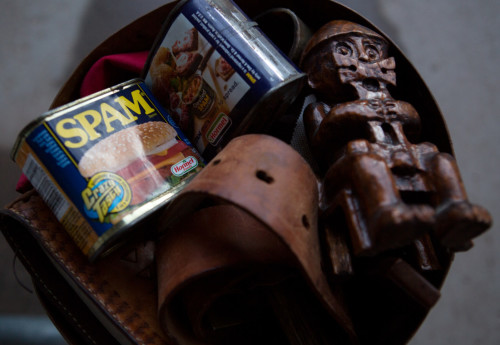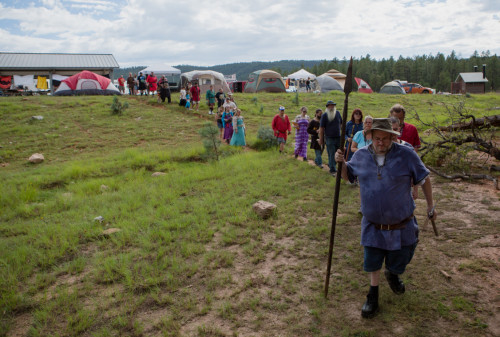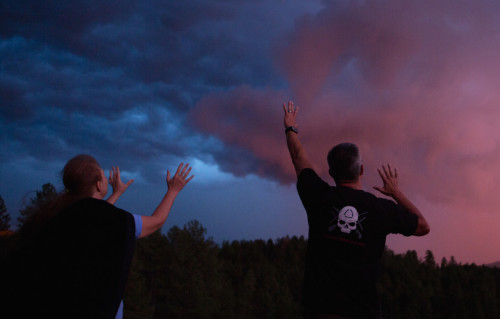
A ceremonial offering bowl, containing Thor and Spam. Photograph courtesy Lauren Pond.
Lauren Pond’s photography had me the first time I saw the Spam. In a photoessay about Heathens, one would expect to find pictures of things like wooden statuettes, leather belts, and offering bowls – the kinds of items that have an intrinsic ritual significance, which seem to automatically activate the area of the brain designated for religion. But one does not expect to find the blue cans of meat nestled in right next to these icons. Of all the things I have read about Valgard Murray, the controversial (to say the least) leader of Asatru Alliance and owner of the items in the photograph, the depths of his predilection for Spam were not among them. But Lauren Pond’s pictures focus on exactly these sorts of details – the human quirks of religious cultures that are often drowned in the seas of theology and ritual.
Pond has been photographing religious communities since 2006, when she traveled to the Indian city Vrindavan, known for being home to more than 15,000 Hindu and Hare Krishna widows. Her photos of the widows capture them attempting to survive despite their cultural stigma. They visit ashrams not only for spiritual reasons, but also for the rupees dispensed for their participation. “I didn’t think of it as a religion documentary at the time,” Pond said. “I thought of it as a humanitarian story.” But gradually Pond began to see that religion was the thread tying her work together. “I never thought that I would be documenting that,” she said, “but I decided that was what I wanted to focus on.”
Since her documentary in Vrindavan, Pond has photographed a number of religious communities. Her photoessays tend to focus on congregations on the fringes of society. Her essay Les Talibes covers the lives of Senegalese children who beg for money while studying the Qur’an. Test of Faith, The Next Generation and A Struggling Tradition examine three very different Pentecostal congregations in the southern United States. Pond takes an ethnographic approach to her work, and in some cases she has spent years developing a rapport with the people she photographs. “I’m not a member [of any of these communities] and I don’t participate in any of the rituals I photograph, but I like to develop a relationship with people,” she said. “That’s why I work on projects for long periods of time, too. That’s what helps build the trust.”

A group of Heathens march to a ritual at Christopher Creek, Arizona.
Photograph courtesy of Lauren Pond.
Among the religious groups Pond has worked with are American Asatruar. Pond has been photographing Heathens since 2010, working with groups in Ohio, California, and Arizona. She covers these experiences in her essay American Heathens, which focuses primarily on her visits to events held by Asatru Alliance in Arizona. The photographs in American Heathens seem to dwell on the apparent anachronisms of their subjects: the photos show Heathens in Viking tunics being photographed by smartphones, longships painted on camper trailers, beer cans scattered among waraxes. Pond says those contrasts are what intrigue her about Asatru: “It’s that blend of American culture and the religious aspects.”
“In photography especially, in our portrayals of religion, I think we tend to focus on the theology and the belief system,” says Pond, “but there is so much outside of that which would help to contextualize the actual beliefs and rituals that gets ignored entirely.” With her work on Asatru, Pond says that, unfortunately, she is more limited to photographing the ceremonial events than she is with some of her other projects, mostly due to time and travel constraints. “I wish I were able to visit on a more daily basis and spend time with them, but it just hasn’t happened so far. Of course, at the Yule Festivals and the Althing, there is a lot of hanging around, but it’s still not daily life.”
Even within the current limitations of the project, however, Pond’s interest in the mixture of the “mundane” with the “ceremonial” remains apparent. In the above photograph, for instance, Heathens in ritual clothing, led by a man holding a spear, are marching off to their rites – yet Pond’s framing of the picture makes sure to include the campground shelter and the village of nylon tents. The photo makes clear that both the “sacred” and “profane” elements of this scene are integral parts of the religious experience.
In the future, Pond hopes to expand her work on Heathenry to include more groups. In addition to the American Heathens essay, the Singles section of her website includes photographs of Heathens in her home state of Ohio, as well as members of a prison kindred in California. She has also attended a Troth Yule ceremony and hopes to soon photograph Heathen communities outside the United States as well. Pond’s American Heathens, along with Jennifer Snook’s recent book – also titled American Heathens – suggests that a turn toward ethnography in work about Heathenry is upon us. Pond thinks that this ethnographic approach is important because of how it humanizes religion. “When you study just theology, all you see is the differences between religions,” she says. “When you break it down into daily life – into moments – you begin to see the people.”

Katherine Stewart and Grant Smith try to ward off storm clouds.
Photograph courtesy Lauren Pond.
When I ask Lauren Pond which photograph in her essay means the most to her, she pauses to think, then directs me to a picture of a man and a woman with their arms raised towards the sky, which glows in vivid blue and pink. “They were having a blot – I want to say it was the Odin blot,” Pond recalls of the photo, taken at a Heathen gathering she photographed at Christopher Creek, Arizona, in 2014. “There were these clouds rolling in all day, and just after the blot started, the skies opened up. That particular image was right before the downpour. They were gathered over by the edge of the campground and were asking for protection.” Pond, who also does nature photography, found this confrontation between the Heathens and the sky fascinating. “I think what was most interesting to me was that, in that moment, there was a definite connection between people and nature.” Ultimately the invocation failed – the downpour came and everyone had to run for cover, and the rest of the weekend was rained out. “I slept in my car,” says Pond. “I guess Arizona has a monsoon season.”
All images were used with permission from the artist and under copyright. © 2006-2015 Lauren Pond. All rights reserved.
The Wild Hunt is not responsible for links to external content.
To join a conversation on this post:
Visit our The Wild Hunt subreddit! Point your favorite browser to https://www.reddit.com/r/The_Wild_Hunt_News/, then click “JOIN”. Make sure to click the bell, too, to be notified of new articles posted to our subreddit.
Went to the last Frithmoot there at christopher creek, rained the entire time. Still, had an awesome time meeting other heathens. And yes, Arizona has a monsoon season.
Actually, the spam can was a ritual item. Back in the 70’s folks would eat the spam as part of the “feast” and use the pulled ring as a symbolic hammer necklace. So this just kinda proves the ignorance of the premise.
Dave,
Are you serious?
I didn’t witness this directly but believe that Bob Stein or any of the old guard could confirm the practice.
To be clear, I’m not suggesting that the Spam was ever considered “holy” like a item actually used directly in the ritual. But more of an inside joke that became a custom.
It’s quite true, and in fact Sunday morning breakfast of Spam is still a tradition at Asatru Alliance events, if I recall correctly.
“The photographs in American Heathens seem to dwell on the apparent anachronisms of their subjects: the photos show Heathens in Viking tunics being photographed by smartphones…”
That’s no more anachronistic than a Catholic priest in his vestments wearing a smart watch.
American Heathens = Rednecks searching for a new faith.
This doesn’t seem to be a very constructive comment tbh.
I liked this ! An intelligent and thoughtful study !
That photo of the storm clouds, with Heathens trying to ward off the storm, is just amazing. I love watching clouds anyway, but wow!
The rightmost clouds are in the “Girdle of Venus” part of the sky, one of my favorite spots in a sunset.
And yes, AZ, NM, and TX at least have monsoon storms during the rainy season (roughly late autumn/winter/early spring), and it might be worse this year, with an El Niño coming to visit. This is the kind of rain Diné call male–and we’d rather have the female variety, as it tends to cause less flooding and mudslides, not killing the tender shoots trying to come up.